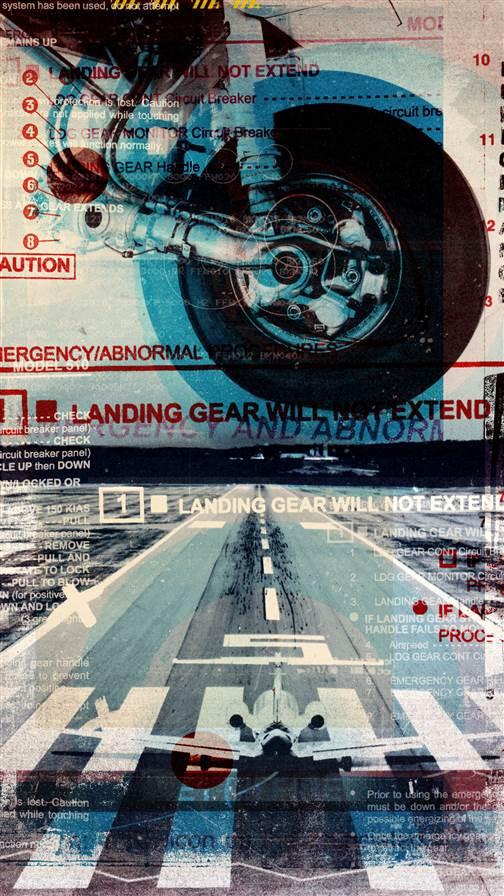Mentor Matters: Don't make things worse
Emergency and abnormal procedures
By Neil Singer
On the evening of March 8, 2001, a Cessna CitationJet experienced a right main gear collapse upon landing in Hamburg, Germany, and subsequently departed the runway after the right wing tip hit the surface. The pilot had notified the tower that he had a landing gear problem, and he had spent about 30 minutes troubleshooting the issue before landing. Despite a visual indication from the tower that all three landing gear were extended, the right main had not reached the full down-and-locked position—a fact the accident investigators attributed to the pilot “not accomplish[ing] the procedure recommended by the manufacturer in case the landing gear is not positively locked.”
 This accident, and a surprisingly large number like it, illustrate the importance of a disciplined adherence to manufacturers’ emergency and abnormal checklists following a system failure. Modern jets have hundreds of procedures developed for nearly every imaginable failure, each with detailed steps to follow. These procedures are approved by the certifying authority and published in chapter four of the airplane flight manual (AFM).
This accident, and a surprisingly large number like it, illustrate the importance of a disciplined adherence to manufacturers’ emergency and abnormal checklists following a system failure. Modern jets have hundreds of procedures developed for nearly every imaginable failure, each with detailed steps to follow. These procedures are approved by the certifying authority and published in chapter four of the airplane flight manual (AFM).
Considering that the AFMs for some jets run more than a thousand pages and sit three inches thick in a hard-covered binder, a cockpit-friendly version is desirable. Manufacturers accomplish this by pulling the emergency and abnormal procedures word for word from the AFM and putting them into a spiral-bound quick reference handbook (QRH), running a more manageable 100 to 200 pages. Tabbed according to the manufacturer’s preferred indexing system, these books are quickly searchable and easy to access in flight.
When presented with a system failure, the pilot’s first step (after the all-important act of flying the airplane) is to perform any memory items that exist for the failure. Memory items are steps of the emergency/abnormal procedure considered so critical that they are completed before the checklist is even located. As the name implies, these items must be memorized; on an initial or recurrent oral exam, 100-percent recall is expected for memory items.
For example, if presented with an engine fire in flight, the manufacturers of many jets will have the pilot, from memory, retard the thrust lever of the offending engine and push a fire button that shuts off fuel to the engine and closes other air and/or hydraulics isolation valves. Some procedures will have the pilot discharge a fire-extinguishing bottle immediately, while others will have the pilot wait a defined period of time before doing so.
Once the pilot has performed any published memory items, it is imperative he or she consult the QRH before taking other steps. The manufacturer creates emergency/abnormal procedures carefully and deliberately, and pilots must follow the procedures without improvising. The temptation can be strong for pilots to do what they think is the obvious step (turn off the offending system, et cetera), but there may be a compelling and irreversible reason not to do so until other steps are executed.
With the QRH out, the first step is to review the memory items, which typically are found inside a box at the top of the procedure. There is always the chance a pilot omitted a step. Next is a methodical, unrushed read down the checklist line by line.
Two potential traps can cause an accidental lack of compliance with the emergency/abnormal procedure. First, many procedures feature one or more “splits” in the checklist, which will direct the pilot down varying paths depending on circumstances presented to the pilot. For example, after performing an action, does the original message alerting the pilot extinguish? If so, one set of steps must be followed, while another set will be needed if the message remains on. These splits can be visually confusing, and many pilots follow the procedure incorrectly when they are first training for a type rating. With practice, a pilot learns to follow the decision tree carefully, and understand which sub-procedure is applicable.
The second opportunity for error exists partially because of the way the procedures can fork; many pilots inadvertently or deliberately (if the pilot thinks the problem is solved and puts the checklist away) do not finish the full procedure as written. The accident in Germany was determined to be a result of partial procedure compliance—the pilot never performed a key step that would have locked the gear down. When the pilot pulled the emergency gear extension handle, the gear uplocks and trapped hydraulic pressure were released, letting the gear free-fall. To assure full downlock, however, a second handle needed to be—and was not—pulled. This would have used nitrogen pressure to push the gear fully down.
Pilots must continue performing all steps of the checklist until the procedure is completed, as indicated by specific verbiage used by the manufacturer—even if it appears the system failure has been resolved. Cessna will state “Procedure Completed,” for example, when there are no steps left for the pilot to execute, while Embraer will present “End” inside a box. Presented with confusing checklist depictions involving forking procedures, it can be easy to incorrectly think a procedure is complete; or, in the case of checklists running multiple pages, it may appear the procedure is complete when the bottom of the page is reached. Here again, an unhurried approach is critical. Pilots can be mindfully looking for the needed verbiage that notifies them they have done all that can be done to resolve the problem.
Neil Singer is a Master CFI with more than 8,500 hours.


